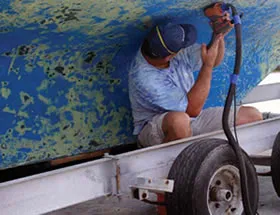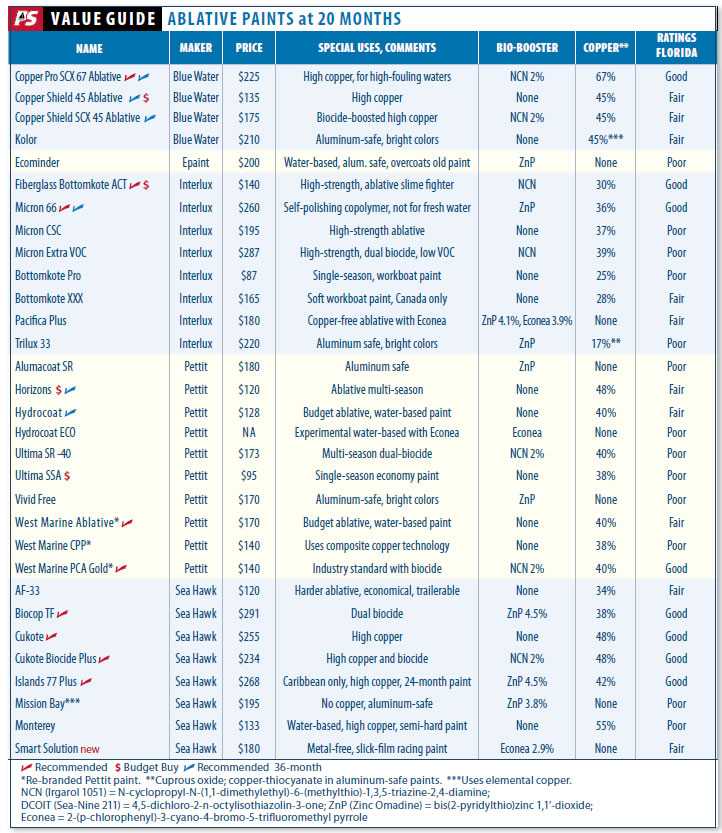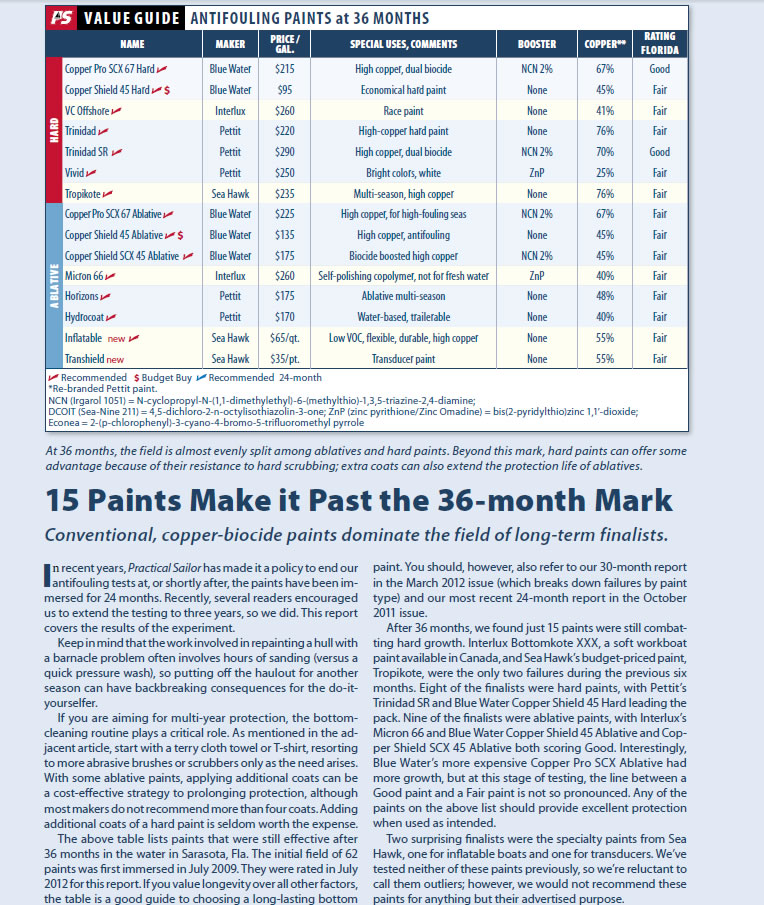
Our annual bottom paint report comes on the heels of some important news regarding the use of copper-based antifouling paint in California. Facing strong opposition from boat owners in the state, Sen. Christine Kehoe (D-San Diego) has decided not to pursue SB 623, legislation she authored to further restrict the use of copper-based paint in the state.
California officials have been searching for ways to reduce the apparently toxic levels of copper in some local waterways for several years. A recent study in San Diego showed the effectiveness of copper-free paints (see PS, March 2011), adding more support to the anti-copper cause, but the Recreational Boaters of California (RBOC) and others opposing the bill argued that the study was unrealistic and that there was no compelling scientific evidence to support a copper ban.
While Californias anti-copper push has stalled for now, the movement continues to gain momentum elsewhere. Last year, Washington state passed legislation prohibiting copper-based antifouling paint on new boats sold after 2018 and banning the use of bottom paints with more than 0.5-percent copper on recreational boats after 2020. The Netherlands, Sweden, and some places in Denmark have already banned the use of copper in paint. In the end, it might be the ingredients high cost, not environmental concerns, that drives manufacturers to new copper-free formulas.
WHAT WE TESTED
Practical Sailor is simultaneously testing three panel sets: one that has been in the water 36 months, another for 20 months, and a batch of 26 new paints that has spent nine months in the water. For details on the 36-month panels, see page 12. For our first look at the new paints, see page 10.
This article focuses on the 20-month panels and is supplemented by the tables on pages 8 and 9. The panels comprise 56 different antifouling paints that PS began testing in November 2010 at the Sarasota Sailing Squadron in Sarasota, Fla. All panels were inspected in June 2012. Participating companies include Blue Water Paints, Interlux, Epaint, Pettit, and Sea Hawk.
Our Value Guide tables are divided by paint category, hard and ablative. These names can be confusing, particularly as more paint makers are introducing hard ablative paints.
The chief determinant in how a paint is categorized is the way it works-the process by which biocide, if present, is activated. However, from a practical standpoint, the key distinction is the maintenance regimen.
Long after theyve lost their antifouling ability, the paint pigments and resins in a hard paint remain on the hull, building up with each recoating. Ultimately, the boat owner faces a flakey, layer-cake of built-up paint that will need to be completely sanded off. Hard paints, as the name implies, are hard, so they hold up well to cleaning, wet-sanding, and trailering-although many hard paints lose their effectiveness if stored out of water for long periods. (A pre-launch wet-sand or vigorous scrub will often reactivate a hard paint stored out of the water.)
Ablative paints wear away, so they don’t build up thick layers. There are two main types-bottom-tier workboat ablatives that slough away with water friction to activate more biocide, and more expensive, copolymer ablatives that release biocides at a controlled rate, which theoretically reduces the amount of copper required for long-term protection. Several ablatives are advertised as hard paints, suitable for trailering and light scrubbing. Our nine-month panel set includes some newly introduced dual-resin ablative paints that claim improved resistance to abrasion.
Most paints are formulated for specific needs: freshwater paints, aluminum-safe paints, racing paints, water-based paints (easy for the do-it-yourselfer to apply), and eco-friendly paints. The best performers in each of these subcategories are designated with a Recommended check mark in the Value Guides. Freshwater sailors should keep in mind that our saltwater test is particularly hard on freshwater paints, and these paints will do much better in lakes for which they were designed. Except where noted, our Recommended paints will provide excellent protection in fresh water, but many of these paints would be overkill for that environment. PS recommends that sailors in smaller lakes steer clear of high-copper saltwater blends to help protect the more fragile closed ecosystems.
HOW WE TESTED
The paint samples were applied to 6-foot-by-2-foot fiberglass panels for testing. Testers followed the makers instructions for preparation and application.
Prior to rating the paints, testers sluiced the panels with a bucket of salt water. Paints were rated Excellent (no growth), Good (light soft growth), Fair (moderate to heavy soft growth), and Poor (hard growth). Any paint rated Fair or better is considered to be continuing to meet its designed purpose.
A Recommended paint performed best overall or rated best among its specialized peers (best aluminum-safe paint, best water-based paint, best racing paint, etc.). The Budget Buy paints are the least expensive among the Recommended paints.
Antifouling tests involve many uncontrolled variables, and we recommend supplementing our data with local knowledge from independent sources. How and where you use your boat, as well as your maintenance regimen, can affect longevity and performance.
BLUE WATER
Based in North Brunswick, N.J., Blue Water Paints makes several general-purpose antifouling coatings that have fared well in our previous tests. In the hard paints category, the Irgarol-boosted Copper Pro SCX 67 Hard scored Good. Economy-priced Copper Shield 45 Hard held its spot at Fair, keeping barnacles away. Blue Water ablative paints were led by the higher-priced Copper Pro SCX 67 Ablative which rated Good, followed closely by the Copper Shield 45 Ablative. The biocide-boosted Copper Shield SCX 45 Ablative scored Fair, as did the aluminum-safe Kolor.
Blue Water Paints are also available under the MarPro label at boatyards or from distributor Donovan Marine (www.donovanmarine.com). The maker had five paints that made it to 36-month mark (see the Antifouling Paints at 36 Months table).
EPAINT
Epaint specializes in copper-free paint, and several types have done well in previous PS tests. The companys top-tier products are among the most expensive in our tests, and because some of its photo-active blends require three coats-versus two required by most makers-the price per square foot is generally higher than conventional paints. The firms two photo-active blends, Z0 and the slicker Z0-HP, faired much better. Both products rated Excellent at 14 months, but in this check-up, they were clearly near the end of their useful lives. ZO-HP was the cleanest of the two, but it was in the bottom half of the other Fair-rated paints when it came to combatting slime. Epaints only ablative blend, Ecominder (one of the few ablatives designed for fragile freshwater environments), failed at the 14-month mark, but it is not designed for high-fouling areas such as our test site.
INTERLUX
Of the six Interlux hard paints we tested, the water-based Bottomkote Aqua had a good year with a Good rating at the 20-month mark. A copper-loaded hard paint boosted with Irgarol, Ultra scored Good at the 20-month mark. VC Offshore high-performance racing paint slipped from Good to Fair. Interluxs two hard, freshwater paints VC 17m and VC 17m Extra were unable to fend off barnacles in the harsh saltwater environment, but both have rated highly among PSs freshwater sailors.
In the ablative category, the Irgarol-boosted Fiberglass Bottomkote ACT continued its hold on the budget-priced blends with one of the few Good ratings among ablative paints. Perennial long-term contender Micron 66 also scored Good. Micron CSC and Micron Extra VOC both dropped from Good to Poor. Interluxs new budget-priced Bottomkote Pro had failed at 14 months. Bottomkote XXX, a soft workboat paint that is available only in Canada and is not recommended for frequent scrubbing, gained ground on competitors with a Fair performance. The reformulated, low-copper Pacifica Plus was one of the cleaner Fair panels, showing only moderate soft growth. The aluminum-safe Trilux 33 rated Good at 14 months and then dropped to Poor.
PETTIT/WEST MARINE
Pettit, a Kop-Coat brand, competes alongside Interlux for the largest share of the recreational antifouling marketplace. The company also manufactures West Marine-brand paint. In the ablative paint category, water-based Hydrocoat, one of Pettits more popular DIY blends (also sold as West Marine Ablative, formerly marketed as West Marine Pure Oceans Ablative), held on to its Fair rating. Horizons was one of the cleaner Fair panels. Two ablative blends that fared well in the 14-month checkup-Ultima SR-40, a $170-plus, copper-based paint boosted with Irgarol, and the budget-priced Ultima SSA-showed hard growth this time, dropping them to Poor ratings. Of the two other Pettit blends sold under the West Marine label, West Marine CPP, dropped from Good to Poor during the six-month interim, while West Marine PCA Gold, which was among the highest rated paints at 14 months, held on to its Good rating.
Pettits hard paints were generally more successful against hard growth than its ablative blends. The new Copper Guard, a single-season paint used by boatyards, was still potent, earning a Fair rating. Super Premium, now discontinued but still available at some retailers for around $200, rated Good. The long-time hard-paint favorite among warm-water sailors, Trinidad, also scored Good. Two related blends, Trinidad Pro and the Irgarol-boosted Trinidad SR, one of the few survivors on our three-year panels, scored Fair. Budget-priced Unepoxy was still holding off hard growth, but showed thicker soft growth compared to its higher-priced peers. Unepoxy Plus, which has a higher copper content than Unepoxy, also earned a Fair rating but showed less growth. The West Marine-branded Bottomshield, a budget-priced paint that uses copper-composite technology to control the release of copper and prolong protection, dropped from Fair to Poor. Vivid, a popular low copper hard paint that is available in a wide variety of bright colors, was free of hard growth and rated Fair.
SEA HAWK
The conventional blends from Florida-based Sea Hawk paints consistently held barnacles at bay for 20 months, although like many makers, its eco-friendly blends suffered. Ablatives with additives dominated the field of top performers for Sea Hawk, with the Irgarol-laced Cukote Biocide Plus and two zinc-boosted paints, Biocop TF and Islands 77 Plus, scoring Good. Of the three, Biocop TF was the cleanest, with only a thin layer of slime that easily rinsed away. The trailerable AF-33 and Smart Solutions, the only completely metal-free paint in the test, also repelled barnacles, but had more soft growth than Fair-rated peers. (Smart Solutions has since been reformulated.) In the hard paint category, Tropikote outperformed the Irgarol-boosted Tropikote Plus, while the other surviving hard paints-the budget-priced, single-season Talon and Sharkskin, with slightly more copper content-had fair to moderate fouling that would require some scrubbing.
CONCLUSION
The 18- to 20-month period is typically the point at which we can clearly see the division between the long-lasting paints suitable for year-round or multi-season protection and those that are only reliable for single-season use. Keep in mind that because we do not scrub or move our panels, you may see better performance-particularly with paints like Interluxs Micron series, which self-polish as a boat moves through the water. Because performance can vary with geography, we also recommend consulting local experts, boatyards, and other boat owners to cross-check recommendations with our list.
Most paints are designed to tolerate cleaning, but if you or your hired cleaner scrub hard at the outset, particularly on some softer ablative paints, you are robbing yourself of expensive protection. Better to use the boat regularly and let water action sluice the hull. If you decide to clean the hull, take a conservative approach. Start with a sponge or T-shirt, and then move up to more aggressive media.
Based on the performance of our 20-month panels, sailors looking for multi-season protection have fewer budget-priced options. In the hard-paint category, only one Good-rated paint was priced under $200, Bottomkote Aqua. Blue Waters Copper Shield 45 Hard, Sea Hawks Talon, and Pettits Unepoxy are also low-budget contenders.
The ablative category offers more options, but again, these were mostly top-tier paints with higher price tags. Interluxs Bottomkote ACT ($140) and West Marines PCA Gold were the two least-expensive paints that rated Good. In the higher price range, Blue Waters Copper Pro SCX 67 Ablative, Interluxs Micron 66, and Sea Hawks Biocop TF, Cukote, Cukote Biocide Plus, and Islands 77 Plus were still offering Good protection. Year-round sailors considering the top-tier paints will also want to look closely at the report on the 36-month panels.
Among aluminum-friendly paints, Epaints ZO and Z0-HP were the only two still barnacle free. Based on our past testing, we don’t expect either to last much beyond the 24-month point. These low-copper paints are also regarded as eco-friendly, and all of the makers have rolled out new lines of eco-friendly paints that we are watching. (See First Look at New Eco-paints and Hard Ablatives.)
Among the racing paints, Epaint ZO-HP and Interluxs VC Offshore were still on top, but both would require regular maintenance. Vivid, also popular with racers, was also barnacle free.
Bottomkote: Aqua looks to be the clear choice for those seeking an easy-to-apply water-based paint, although we have yet to find a water-based paint that consistently reaches the 24-month mark.

Checks indicate Recommended paints in one or more key categoriesoverall, aluminum safe, water based, eco-friendly, and racing. Budget Buy paints are the least expensive of the Good paints. Prices are estimates and do not include shipping. Copper percentages are by weight, so paints with heavier solids in the resin may have more total copper, but a lower percentage.








































We have been using (and recommending) Blue Water Copper Shield 45 Ablative for 7 years based on Practical Sailor recommendations and excellent results. Until this year. Blue Water has been acquired by Sea Hawk. Neither the gallon of Copper Shield 45 Admiral Green nor quart of Shelter Island Plus White purchased in April 2020 would mix without leaving huge numbers of ‘chunks’ that needed to be strained out. The Sea Hawk rep essentially blamed our experience on our mixing (even though we have never had this issue in almost 40 years of bottom painting….) and says their test sample of the Copper Shield manufactured in January 2020 is fine, and the Shelter Island can they sold wasn’t manufactured by them, so it’s not their problem. After this experience, I will never buy or recommend Blue Water or Sea Hawk paints again.